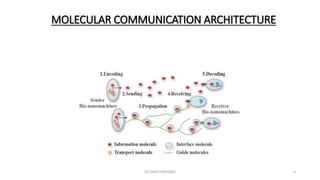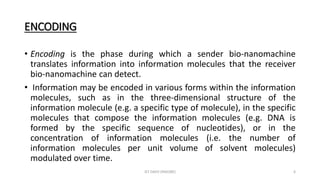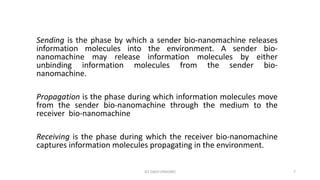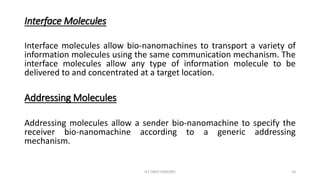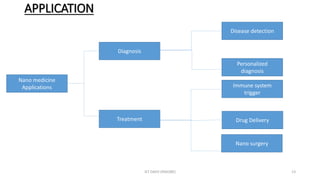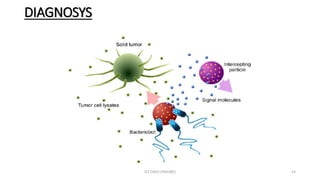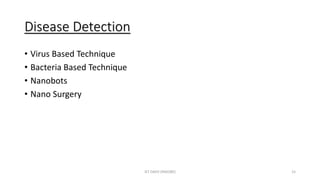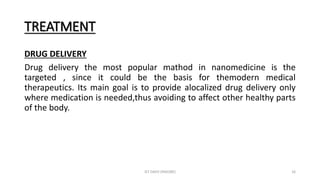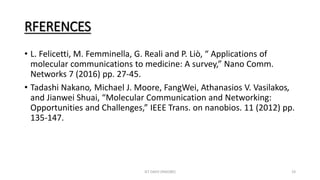Molecular communication
- 1. A PRESENTATION ON MOLECULAR COMMUNICATION & ITS APPLICATION PREAPERED BY PUNEET SINGH THAKUR ME (D.I.) IET DAVV Roll No. -15DI2109 1IET DAVV (INDORE)
- 2. MOLECULAR COMMUNICATION Molecular communication is a Nano network design strategy where a transmitter emits information molecules that are carried to an intended receiver. This strategy can take advantage of the many mechanisms in cells and subcellular structures that already use the emission of molecules for communication. This class of communications takes inspiration from some existing communication mechanisms between biological entities. It consists of using relatively small molecules, such as hormones and other small proteins (e.g. cytokines), peptides, carbohydrates, lipids and combinations of them, which can propagate from a transmitter to receivers. 2IET DAVV (INDORE)
- 3. BASIC COMPONENT INVOLVE IN EACH PHASE OF MOLECULAR COMMUNICATION Encoding Sending Propogation Receiving Decoding 3IET DAVV (INDORE)
- 4. MOLECULAR COMMUNICATION ARCHITECTURE 4IET DAVV (INDORE)
- 5. SENDER AND RECEIVER NANOMACHINE Two basic approaches for engineering bio-nanomachines with functionality for communication are the modification of existing biologicalcells or the production of simplified cell-like structures using biological materials Modified biological cells Artificial cells 5IET DAVV (INDORE)
- 6. ENCODING • Encoding is the phase during which a sender bio-nanomachine translates information into information molecules that the receiver bio-nanomachine can detect. • Information may be encoded in various forms within the information molecules, such as in the three-dimensional structure of the information molecule (e.g. a specific type of molecule), in the specific molecules that compose the information molecules (e.g. DNA is formed by the specific sequence of nucleotides), or in the concentration of information molecules (i.e. the number of information molecules per unit volume of solvent molecules) modulated over time. 6IET DAVV (INDORE)
- 7. Sending is the phase by which a sender bio-nanomachine releases information molecules into the environment. A sender bio- nanomachine may release information molecules by either unbinding information molecules from the sender bio- nanomachine. Propagation is the phase during which information molecules move from the sender bio-nanomachine through the medium to the receiver bio-nanomachine Receiving is the phase during which the receiver bio-nanomachine captures information molecules propagating in the environment. 7IET DAVV (INDORE)
- 8. Decoding is the phase during which the receiver bio-nanomachine, upon capturing information molecules, decodes the received molecules into a chemical reaction.Chemical reactions for decoding at the receiver bio-nanomachine may include the production of new molecules, the performing of a simple task, or the production of another signal (e.g.,sending other information molecules). 8IET DAVV (INDORE)
- 9. Informational molecules Information molecules carry information and propagate from a sender bio-nanomachine to a receiver bio-nanomachine in the environment. The size and structure of the information molecules may affect how the information molecules propagate in the environment. Guide and Transport Molecules Guide and transport molecules provide reliable mechanisms for propagating informationmolecules.A required functionality for these molecules is to direct the propagation of information molecules toward target locations (i.e., receiver bio-nanomachines). Guide and transport molecules can be viewed as bionanomachines specialized for transporting molecules. 9IET DAVV (INDORE)
- 10. Interface Molecules Interface molecules allow bio-nanomachines to transport a variety of information molecules using the same communication mechanism. The interface molecules allow any type of information molecule to be delivered to and concentrated at a target location. Addressing Molecules Addressing molecules allow a sender bio-nanomachine to specify the receiver bio-nanomachine according to a generic addressing mechanism. 10IET DAVV (INDORE)
- 11. ADVANTAGES • Biocompatible • Minimally invasive • Ultrafast • Nano scale Devices Used • Minimum Side Effect • Simultaneous Diagnosis & Treatment 11IET DAVV (INDORE)
- 12. Telecommunication & molecular communication 12IET DAVV (INDORE)
- 13. APPLICATION 13 Nano medicine Applications Diagnosis Treatment Drug Delivery Nano surgery Immune system trigger Personalized diagnosis Disease detection IET DAVV (INDORE)
- 15. Disease Detection • Virus Based Technique • Bacteria Based Technique • Nanobots • Nano Surgery 15IET DAVV (INDORE)
- 16. TREATMENT DRUG DELIVERY Drug delivery the most popular mathod in nanomedicine is the targeted , since it could be the basis for themodern medical therapeutics. Its main goal is to provide alocalized drug delivery only where medication is needed,thus avoiding to affect other healthy parts of the body. 16IET DAVV (INDORE)
- 17. ADVANTAGES • reduction of death probability due to cardiovascular diseases; • possibility of reducing time-consuming and potentially invasive cardiovascular diagnostic investigations and thus to improve the quality of life of patients • reduction of iatrogenic disease due to unnecessary/ inappropriate preventive therapies; • significant decrease of national health service expenditures. 17IET DAVV (INDORE)
- 18. FUTURE SCOPE • Environmental application Environment monitoring Waste/Pollution control • Large Scale Healthcare • Manufacturing Application Pattern and Structure Formation 18IET DAVV (INDORE)
- 19. RFERENCES • L. Felicetti, M. Femminella, G. Reali and P. Liò, “ Applications of molecular communications to medicine: A survey,” Nano Comm. Networks 7 (2016) pp. 27-45. • Tadashi Nakano, Michael J. Moore, FangWei, Athanasios V. Vasilakos, and Jianwei Shuai, “Molecular Communication and Networking: Opportunities and Challenges,” IEEE Trans. on nanobios. 11 (2012) pp. 135-147. 19IET DAVV (INDORE)




